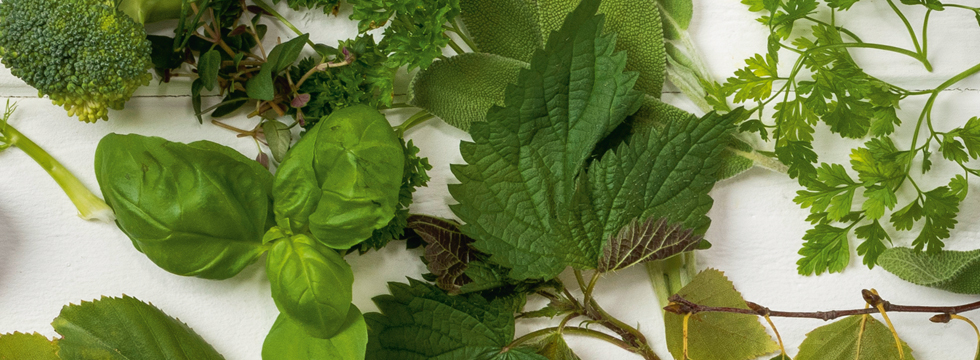
Helpful Herbs
Even in prehistoric times plants were used as valuable treasures of nature against diseases. Their mysterious healing properties were already proven, but still unexplored scientifically. Then as now, plants are still used as remedies and are also recognized medically. In many countries, there is a long tradition of herbalists treating their patients with all sorts of extracts and tinctures from medicinal plants to the benefit of health. Medicinal herbs are defined as plants whose leaves, flowers, stems or roots have specific therapeutic properties. Even wild animals instinctively seek out grasses, plants, roots and barks to strengthen their vitality or consume herbs when in pain. We want to describe some of these plants which are beneficial to our pets. You will also find these herbs in our products as an important component of their natural nutrition or for beneficial external application.
We hope you enjoy reading this book of nature!

Aloe
Aloe is a genus of plants from the warm regions and occurs especially in South Africa and southern Europe. Here in Germany, it grows in greenhouses. Profile: Aloe becomes 60 cm high with 4 -7 cm thick round stems. The leaves are thick and fleshy. Flowering time is in June. The un-processed aloe contains aloin and this has a laxative effect. It also has a special affinity for the digestive organs and is therefore recommended for chronic gastritis. Furthermore, aloe is used to treat wounds, even in poorly healing wounds and is also used to treat ulcers.
Scientific name: Aloe vulgaris.
Used plant part Leaves.
Ingredients:: Aloine.

Artichoke
The artichoke is a medicinal plant with a long history. They aid in the digestion of fat.
Profile: It belongs to the thistle family and thrives in warm regions, where it grows mainly in the winter months. The benefits of artichokes are that they are antiseptic and lowers the blood lipid. It has a stimulating effect on the liver and kidney, but also promotes blood circulation and detoxification in the body.
Scientific name: Cynara scolymus.
Plant part used: all parts of the plant.
Ingredients: The artichoke essentially contains the carbohydrate inulin, protein, calcium, iron, provitamin A and vitamin B1.
Harvest: from February.

Wild garlic
In the Edda, the large collection of Germanic popular myths, the wild garlic appears as one of the first plants after the creation of the world. Wild garlic belongs to the bulb family and is wild in almost all of Europe. The plant is about 20 - 50 cm high and blooms with many white star-shaped flowers. Wild garlic is easily confused with the venomous and the highly poisonous lily of the valley. It is a nutrient indicator, because wild garlic only grows where the soil is particularly nutritious.
Profile: has a positive effect on skin conditions, worm infestation, intestinal complaints and arteriosclerosis (the thickening and hardening of the walls of the arteries). It is also recommended as a blood-purifying spring cure.
Scientific name: Allium ursinum.
Used plant part: Leaves.
Ingredients: rich in vitamin C, magnesium, iron and manganese. Sulfides are effective against bacteria and fungi.
Harvest: May and June.

Birch
The birch is native to Europe and North Asia. It grows on sandy, but also on boggy soils.
Profile: Birch trees have a scientifically proven diuretic effect. When the body accumulates water somewhere, the birch leaves are able to quickly withdraw the blocked liquid. At the same time there is an increased excretion of urinary substances, which has a beneficial effect on metabolic disorders such as rheumatism and gout. Birch tea is often used to treat skin conditions. It can positively influence chronic eczema. Birch water is used for head and hair care.
Scientific name: Betula alba.
Plant part used: Mainly the young birch buds, the young leaves, but also the fresh birch sap.
Ingredients: The young leaves contain essential oils, tannins and acidic and neutral saponins. Birch tar (made by blanching birch wood and bark) contains mainly carbolic acid and creosol.

Nettle
The nettle has been valued and used as a medicinal plant since ancient times. It is mainly used for rheumatic diseases, but also as a spring cure for purifying blood.
Location: You can actually find the nettle almost everywhere, on roadsides, in gardens or on composting grounds. It is up to 1.5 m high and has long burning hairs on leaves and stems, which cause itchy wheals on contact with the skin. It is a diuretic, anti-inflammatory and hematopoietic. It is also often used as a tonic for general immune deficiency, skin disorders and iron deficiency.
Scientific name: Urtica dioica, Urtica urens.
Plant part used: Leaves and roots.
Ingredients: Stinging nettles have flavonoids, sugar-lowering glucocinines, silica, valuable minerals, iron, provitamin A, vitamin C, plenty of xanthophyll and chlorophyll.
Harvest: young shoots and leaves in spring, roots in late summer. Overall, the plant can be harvested into the fall.

Fennel
Fennel is native to Asia and was already popular as a medicinal plant with the ancient Egyptians.
Benefits: as a home remedy, fennel is often used for bloating and digestive problems and helps with eye inflammation. In addition to its essential oils, which have a positive effect on the mucous membranes, its anti-spasmodic and antibiotic effect is also helpful for flatulence and stomach and intestinal complaints.
Scientific name: Foeniculum vulgare.
Plant part used: tuber with leaves and the fruits.
Ingredients: iron, potassium, calcium, vitamin A, vitamin B1, B2, vitamins C and E and essential oils such. Anethole.
Harvest: summer, autumn.

Elderberry
The elderberry is found throughout Europe. Since it spreads not only by seeds, but also by plant shoots, it is difficult to expel.
Characteristics: well-known is the urea, sweat and milk-driving effect of the elderberry or "lilac blossoms", the berry also has the same effect. The berries have blood-purifying and hematopoietic character and cleanse all internal organs.
Scientific name: Sambucus nigra.
Used plant part: both leaves and roots as well as the elderflower and the well-known elderberries.
Ingredients: Elderberry has plenty of vitamin C in the fresh flowers, the plant contains iron, copper and turpentine containing essential oils. Furthermore, the berries contain plenty of vitamins A, B and C (more than blueberry and raspberry).

Hops
Hops grow not only grow wild, it has also been cultivated in Germany since the eighth century.
Characteristics: the medical effect is mainly based on the bitter substances. Hops have an appetite-stimulating, gastrointestinal-strengthening, nerve-calming and sleep-inducing effect. It is also said to have an inhibitory effect on bacteria.
Scientific name: Humulus lupulus.
Plant part used: Fruit cone.
Ingredients: Lupulin, hop bitter and essential oils, tannic acid and hop bitter.

Garlic
Through a study published by the Zurich Veterinary Pharmacology and Toxicology, garlic repeatedly appears as a negative headline. It states that a toxic dose of garlic is 5g / kg body weight or 1.25 ml / kg body weight during a dose covering 7 days. However, this information only appears if you are really searching for it. The home page about the toxicity level of Allium sativum states that it is - toxic to highly toxic. This information seems to be enough for some dog owners to know that garlic can only be harmful to the dog. This afore mentioned quantity is nonsense. This means that a dog with a sample weight of 15 kg will need a dose of 75 g garlic daily! A clove of garlic weighs between 2 - 3 g. This would mean that a 15 kg dog would need to receive 25 garlic cloves daily.
No dog does that. Garlic is one of the oldest medicinal plants known to man and has been used since ancient times for healing and as a tonic.
Traditionally, garlic is often used for the following conditions: gastrointestinal disorders with diarrhea or constipation, flatulence and intestinal inflammation. Garlic kills diseased intestinal bacteria and promotes the coli bacteria (normal intestinal dwellers). It is also used for diseases of the air and respiratory tract such as bronchitis, whooping cough and asthma. It is effective for high blood pressure, arteriosclerosis and myocardial (blood flow to the heart) insufficiency. Furthermore, garlic has a worming effect and is used in Indian medicine as a strengthening agent.
Important ingredients of garlic:
Carbohydrates, protein, fat, calcium and phosphorus, magnesium, iron, vitamins B1, B2 and C, ferments, inulin and the sulfur-containing essential oil allicin. Allicin is the compound that causes the smell of garlic and is attributed to the health-promoting effect of garlic.
A question regarding garlic was submitted to the Veterinary Toxicological Institute of the University of Zurich. Prof. Dr. med. Nägeli answered, "Feeding garlic to dogs can be good for their health. About the actual effect as a repellent (repellent against stinging insects) I know nothing. A daily dose of 4 g of fresh garlic clove is recommended. For powders etc. I have no dosage recommendation."
Dr. Korthäuer answered, "Garlic intoxications have not occurred to me in 20 years of veterinary activity, although some pet owners are already overdoing it with the garlic supply to their dog."
At Naturavetal the principle applies: too much does not help at all! That's why our Canis Plus complete food contains only a very small amount of garlic.
In a variety of studies, no clinical symptoms related to Allium sativum intoxication have been reported in dogs. All tested dogs have been given Canis Plus complete feed for several years and were healthy, even the blood tests showed no abnormalities.

Lavender
Lavender is native to northern Italy and southern France, but now it also beautifies the gardens of Germany.
Characteristics: with its essential oils, lavender works on various organ systems, it stimulates the digestive system by stimulating the stomach, relieves spasms of the respiratory tract, excretes water on the kidneys and soothes the nerves. Even with infected wounds, lavender acts as an antiseptic.
Scientific name: Lavendula officinalis.
Plant part used: Lavender flowers and leaves.
Ingredients: Lavender contains essential oils, tannins, glycoside and saponin.

Dandelion
Dandelion is also known as Milk Thistle. In the Middle Ages the dandelion was used for gout and rheumatic complaints. Even today it is very much appreciated for joint inflammation and water retention.
Location: Dandelion can be found almost everywhere. It belongs to the asteraceae family and grows up to 20 cm high.
Characteristics: The stem contains a white milky juice. Dandelion tastes rather bitter and unappetizing. It stimulates the metabolism and is used as a tea for liver and gall bladder problems as well as for blood purification and general old age.
Scientific name: Traxacum officinale.
Plant part used: roots and leaves.
Ingredients: Dandelion contains an antibiotic substance, vitamins of the B and C group, the bitter substance taraxacin and inulin. Inulin is a carbohydrate that converts into fructose and is said to have a special anti-diabetic effect.

Parsley
Parsley is one of the most known culinary herbs. Even among the ancient Greeks, parsley was used for its diuretic effect and as an aid to injuries such as bruising, ulcers and mosquito bites.
Located: Parsley is a umbellifer (having its flowers arranged in umbels) and has carrot-like taproots. It is a perennial plant that can grow to over a meter in height.
Characteristics: it provides important support in infections and immune deficiency, promotes blood formation and is a rich source of minerals. In addition, it has a great effect on kidneys and blood vessels. Scientific name: Petroselinum crispum. Plant part used: fresh leaves.
Ingredients: Parsley has a remarkably high content of protein, minerals, calcium, iron and provitamin A and B 1, B2, vitamin E and folic acid. Already 5 g leaf parsley cover the daily requirement of provitamin A and vitamin C.

Sage
Sage was formerly referred to as a bacteria killer. Sage is mainly grown in gardens and is rarely found in the wild. The sage plant is very hardy. In ancient times, sage was highly valued as a remedy.
Characteristics: Sage acts as an infusion bactericidal, providing quick healing to wounds. It is also used for reducing the overproduction of perspiration i.e sage is an antiperspirant.
Scientific name: Salvia officinalis.
Plant part used: Leaves and young shoots. Ingredients: essential oils with salviol, cineole, camphor, tannins and resins

Pansy
Pansies: "The big petal is the stepmother who presents herself in a colorful, gorgeous dress with lots of jewelry. The next medium-sized petals are their appropriately decorated daughters, while the two stepdaughters, small and unadorned, have only one sepal as jewelry. Then God took pity on them, turning over the flower that they appeared at the top, and the wicked stepmother at the bottom."
Characteristics: the leaves and flowers have a stimulating effect on the skin. They help to cleanse the kidneys and help against chronic rashes.
Scientific name: Viola tricolor.
Plant part used: leaves and flowers.
Harvest: April - September.






